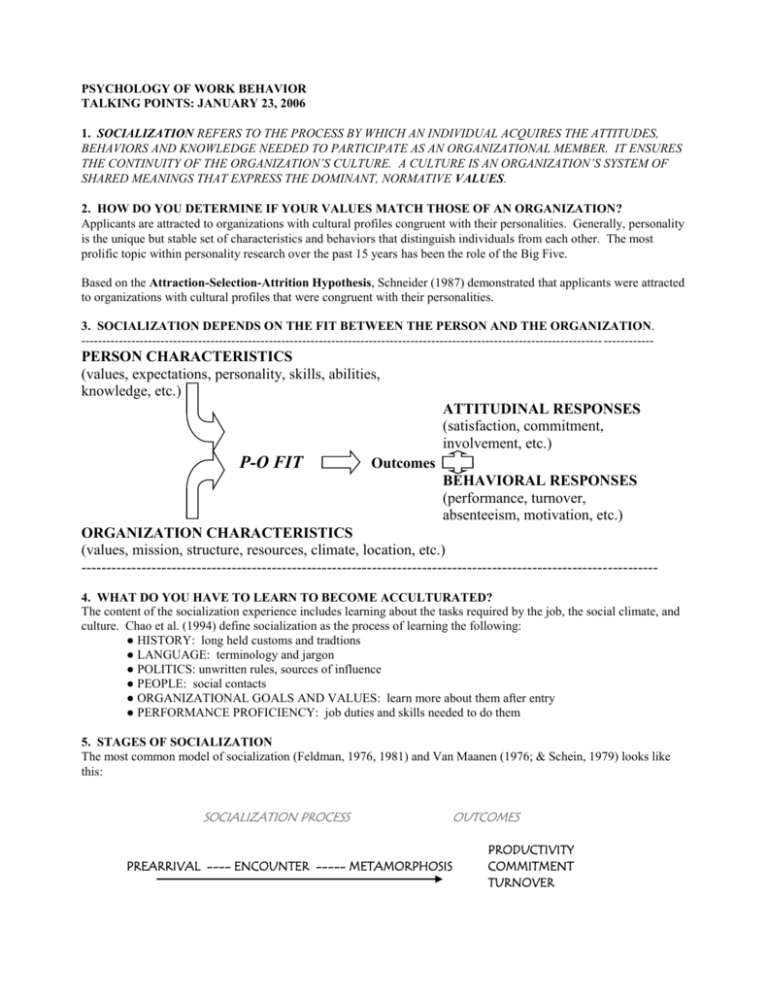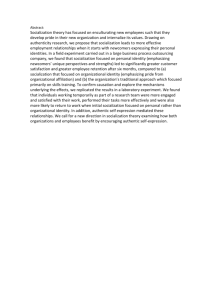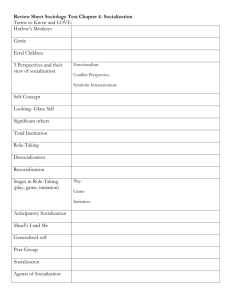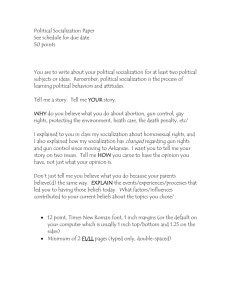January 23 - Nora P. Reilly, Ph.D.
advertisement

PSYCHOLOGY OF WORK BEHAVIOR TALKING POINTS: JANUARY 23, 2006 1. SOCIALIZATION REFERS TO THE PROCESS BY WHICH AN INDIVIDUAL ACQUIRES THE ATTITUDES, BEHAVIORS AND KNOWLEDGE NEEDED TO PARTICIPATE AS AN ORGANIZATIONAL MEMBER. IT ENSURES THE CONTINUITY OF THE ORGANIZATION’S CULTURE. A CULTURE IS AN ORGANIZATION’S SYSTEM OF SHARED MEANINGS THAT EXPRESS THE DOMINANT, NORMATIVE VALUES. 2. HOW DO YOU DETERMINE IF YOUR VALUES MATCH THOSE OF AN ORGANIZATION? Applicants are attracted to organizations with cultural profiles congruent with their personalities. Generally, personality is the unique but stable set of characteristics and behaviors that distinguish individuals from each other. The most prolific topic within personality research over the past 15 years has been the role of the Big Five. Based on the Attraction-Selection-Attrition Hypothesis, Schneider (1987) demonstrated that applicants were attracted to organizations with cultural profiles that were congruent with their personalities. 3. SOCIALIZATION DEPENDS ON THE FIT BETWEEN THE PERSON AND THE ORGANIZATION. ----------------------------------------------------------------------------------------------------------------------------- ------------ PERSON CHARACTERISTICS (values, expectations, personality, skills, abilities, knowledge, etc.) ATTITUDINAL RESPONSES (satisfaction, commitment, involvement, etc.) P-O FIT Outcomes BEHAVIORAL RESPONSES (performance, turnover, absenteeism, motivation, etc.) ORGANIZATION CHARACTERISTICS (values, mission, structure, resources, climate, location, etc.) ------------------------------------------------------------------------------------------------------------------4. WHAT DO YOU HAVE TO LEARN TO BECOME ACCULTURATED? The content of the socialization experience includes learning about the tasks required by the job, the social climate, and culture. Chao et al. (1994) define socialization as the process of learning the following: ● HISTORY: long held customs and tradtions ● LANGUAGE: terminology and jargon ● POLITICS: unwritten rules, sources of influence ● PEOPLE: social contacts ● ORGANIZATIONAL GOALS AND VALUES: learn more about them after entry ● PERFORMANCE PROFICIENCY: job duties and skills needed to do them 5. STAGES OF SOCIALIZATION The most common model of socialization (Feldman, 1976, 1981) and Van Maanen (1976; & Schein, 1979) looks like this: SOCIALIZATION PROCESS PREARRIVAL ---- ENCOUNTER ----- METAMORPHOSIS OUTCOMES PRODUCTIVITY COMMITMENT TURNOVER ● STAGE 1 The first stage encompasses all the learning that occurs before a new member joins the organization. It is also called the anticipatory or pre-entry socialization stage. Newcomers arrive with their own values, attitudes, and expectations. A good selection process ensures that you have selected the “right” type, and begins with recruiting practices. The manner in which the recruiting process is conducted is essential to first impressions. In addition, realistic job previews help address the question of congruence. Phillips’ (1998) meta-analysis of RJPs suggests a small but reliable effect. Also, when newcomers arrive, they do so with a psychological contract. Because psychological contracts are not written, they are based on expectations. What are the possible influences of perceptions of work relationships? New employees form psychological contracts that are implicit or explicit with their employers; these are essentially agreements on mutual expectations. However, these may change over time. It would be nice if we could learn early on if a newcomer’s expectations have been violated to the point that they wish to leave the organization, but how could we determine that? ● STAGE 2 In the encounter stage, the employee finds out what the organization is really like and may find that reality conflicts with her or his expectancies. Newcomers might often experience role ambiguity directly as a result of an orientation program. Socialization tactics developed by the organization itself can help (or hinder) a newcomer’s acclimation to a new role. Impression management issues often arise during the encounter stage. ● STAGE 3 The third stage of socialization involves relatively long-lasting changes. It is called the metamorphosis or change and acquisition stage. The new employee masters the skills of the job, successfully performs in role, and adjusts to work group values and norms. Both behavioral and affective outcomes of socialization become apparent. The process influences the new employee’s work productivity, commitment to the organization’s objectives, and the decision to stay with the organization. 6. WHAT STRATEGIES ARE USED TO SOCIALIZE NEWCOMERS TO THE ORGANIZATION? a. Recruiting b. Realistic Job Previews c. Orientation d. Training e. Mentoring f. Proactive socialization by the newcomer We will discuss training in some detail.







